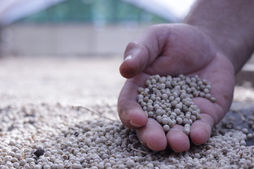Black pepper, originally from India, also known as Indian pepper, is a climbing plant, being the most common and most important of spices. Its cultivation is widespread in regions of tropical climate, at latitudes up to 20 ° N and 20 ° s and altitudes up to 2,400 m. The introduction of pepper in Brazil occurred in the seventeenth century in the state of Bahia, and was then taken to Paraíba, Maranhão and Pará. In Espírito Santo, cultivation was first introduced in Linhares, with seedlings originating from Pará and later, new introductions were made from the State of Bahia. Currently, in Espírito Santo area is cultivated over 2,300 ha, predominantly the cultivars Singapore, São Matheus, Bragantina, Guajarina and Iaçara. Cultivation development in the region is closely linked to many families of the Italian colony who settled in the region and were the precursors in the planting of black pepper, one of them being the Sacconi family.

Pepper
History

BLACK KINGDOM PEPPER
Cultivation To produce black pepper, the bunches are harvested when the bunches are fully developed, light green or yellow in color. Then they are threshed mechanically or manually, after which they are taken for drying in the sun. There are producers who do not usually thresh the pepper and in this case, the bunches are put to dry and during the drying process are detached from the shaft. To make it even, remove with a small wooden squeegee the axes of the bunches that are mixed with the product. At this time the pepper is separated and classified by weight. Sacconi constantly invests in new technologies, threshing the curls mechanically and with the same efficiency can make drying with dryers which speeds production.
Use Its grains, dried and ground, are widely used in the cooking of various countries, as a natural product in the production of spices. It has a strong
and spicy taste.
Cassation: ASTA, B1 and B2
WHITE KINGDOM PEPPER Cultivation For the preparation of white pepper, the bunches are harvested when the fruits are yellow or red in color. After being threshed, they are macerated in masonry tanks or in running water. To prevent putrefying odor, limestone can be added to raise the water pH. Every three days the water is changed, on the 12th day, the tanks are drained and washed to be reused. The pepper produced by this process has the white color and the characteristic odor of black pepper. Once peeled and washed, the pepper is placed on a ground-free, sun-dried suspended platform and then packed in double polypropylene bags. This white pepper process is unique to Sacconi in the region.
Use White pepper has the same use as black pepper, being equivalent in flavor and weight, but has a more refined appearance.
Classification: Asta, B1 and B2










